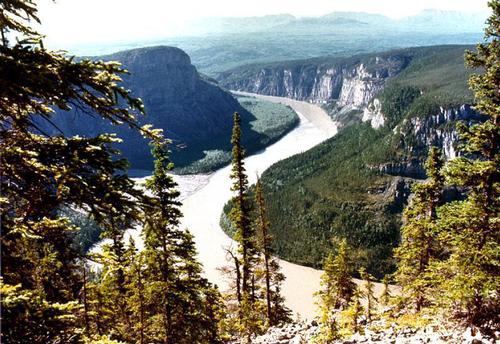1) Canadian Rocky Mountain Parks
 Canada Canada
Date of Inscription: 1984
Extension: 1990
Criteria: (vii)(viii)
Property: 2306884.0000 ha
Provinces of British Columbia and Alberta
N51 25 29 W116 28 47
Ref: 304bis |
 |
Brief Description
The contiguous national parks of Banff, Jasper, Kootenay and Yoho, as well as the Mount Robson, Mount Assiniboine and Hamber provincial parks, studded with mountain peaks, glaciers, lakes, waterfalls, canyons and limestone caves, form a striking mountain landscape. The Burgess Shale fossil site, well known for its fossil remains of soft-bodied marine animals, is also found there.
Other Languages:
English French Arabic Chinese Russian Spanish
Canadian Rocky Mountain Parks |
Gorgo Public Domain
More pictures ...
Statement of Significance
Renowned for their scenic splendor, the Canadian Rocky Mountain Parks are comprised of Banff, Jasper, Kootenay and Yoho national parks and Mount Robson, Mount Assiniboine and Hamber provincial parks. Together, they exemplify the outstanding physical features of the Rocky Mountain Biogeographical Province. Classic illustrations of glacial geological processes — including icefields, remnant valley glaciers, canyons and exceptional examples of erosion and deposition — are found throughout the area. The Burgess Shale Cambrian and nearby Precambrian sites contain important information about the earth’s evolution.
Criteria
(vii) The seven parks of the Canadian Rockies form a striking mountain landscape. With rugged mountain peaks, icefields and glaciers, alpine meadows, lakes, waterfalls, extensive karst cave systems and deeply incised canyons, the Canadian Rocky Mountain Parks possess exceptional natural beauty, attracting millions of visitors annually.
(viii) The Burgess Shale is one of the most significant fossil areas in the world. Exquisitely preserved fossils record a diverse, abundant marine community dominated by soft-bodied organisms. Originating soon after the rapid unfolding of animal life about 540 million years ago, the Burgess Shale fossils provide key evidence of the history and early evolution of most animal groups known today, and yield a more complete view of life in the sea than any other site for that time period. The seven parks of the Canadian Rockies are a classic representation of significant and on-going glacial processes along the continental divide on highly faulted, folded and uplifted sedimentary rocks.
2) Dinosaur Provincial Park
 Canada Canada
Date of Inscription: 1979
Criteria: (vii)(viii)
Property: 7493.0000 ha
N50 46 4 W111 29 32
Ref: 71 |
 |
Brief Description
In addition to its particularly beautiful scenery, Dinosaur Provincial Park – located at the heart of the province of Alberta's badlands – contains some of the most important fossil discoveries ever made from the 'Age of Reptiles', in particular about 35 species of dinosaur, dating back some 75 million years.
Other Languages:
English French Arabic Chinese Russian Spanish

Dinosaur Provincial Park |
Kevin Saff Kevin Saff
More pictures ...
Statement of Significance
Dinosaur Provincial Park contains some of the most important fossil specimens discovered from the "Age of Dinosaurs" period of Earth's history. The property is unmatched in terms of the number and variety of high quality specimens, over 60 of which represent more than 45 genera and 14 families of dinosaurs, which date back 75-77 million years. The park contains exceptional riparian habitat features as well as "badlands" of outstanding aesthetic value.
Criteria
(vii) Dinosaur Provincial Park is an outstanding example of major geological processes and fluvial erosion patterns in semi-arid steppes. These "badlands" stretch along 24 kilometers of high quality and virtually undisturbed riparian habitat, presenting a landscape of stark, but exceptional natural beauty.
(viii) The property is outstanding in the number and variety of high quality specimens representing every known group of Cretaceous dinosaurs. The diversity affords excellent opportunities for paleontology that is both comparative and chronological. Over 300 specimens from the Oldman Formation in the park including more than 150 complete skeletons now reside in more than 30 major museums.
3) Nahanni National Park
 Canada Canada
Date of Inscription: 1978
Criteria: (vii)(viii)
Property: 476560.0000 ha
Northwest Territories
N61 32 50 W125 35 22
Ref: 24 |
 |
Brief Description
Located along the South Nahanni River, one of the most spectacular wild rivers in North America, this park contains deep canyons and huge waterfalls, as well as a unique limestone cave system. The park is also home to animals of the boreal forest, such as wolves, grizzly bears and caribou. Dall's sheep and mountain goats are found in the park's alpine environment.
Other Languages:
English French Arabic Chinese Russian Spanish

Nahanni National Park
More pictures...
Statement of Significance
Nahanni National Park is a 4,700 sq. km. undisturbed natural area of deep river canyons cutting through mountain ranges, with huge waterfalls and complex cave systems. The geomorphology of the park is outstanding in its wealth of form and complexity of evolution. Fluvial processes and features predominate. Within the park are examples of almost every distinct category of river or stream that is known along with one of North America’s huge waterfalls, Virginia Falls. The Flat and South Nahanni rivers are older than the mountains they dissect and have produced the finest examples of river canyons in the world, north of 60o. The injection of igneous rock through tectonic activity has resulted in spectacular granitic peaks.
Criteria
(vii) The Nahanni River is one of the most spectacular wild rivers in North America, with deep canyons, huge waterfalls, and spectacular karst terrain, cave systems and hot springs. Exposure of geologic and geomorphologic features includes the meanders of ancient rivers, now raised high above present river levels.
(viii) In Nahanni National Park, there is exceptional representation of on-going geological processes, notably fluvial erosion, tectonic uplift, folding and canyon development, wind erosion, karst and pseudo-karst landforms, and a variety of hot springs. The major geologic and geomorphologic features provide a combination of geological processes that are globally unique.